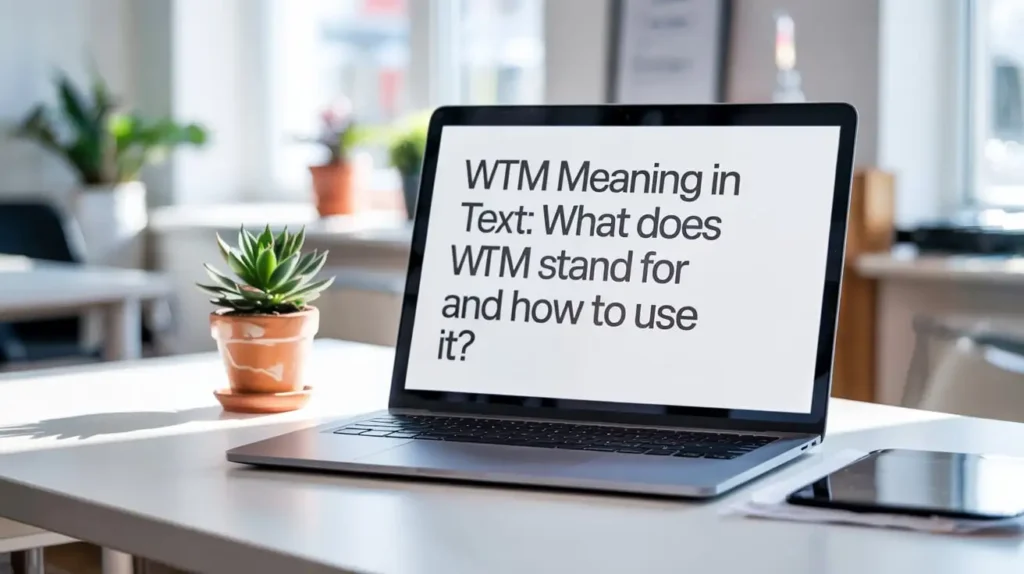In the fast-paced world of texting and social media, acronyms have become a language of their own. One abbreviation you’ve likely seen popping up in conversations, Instagram comments, or TikTok captions is WTM. But what exactly does WTM mean, and how do you use it correctly?
In this article, we’ll break down the meaning of WTM, explore its origins, compare it with similar acronyms, and provide practical examples so you can use it confidently in your texts and online chats. By the end, you’ll feel ready to drop WTM into your digital conversations naturally.
What Does WTM Stand For?
WTM stands for “What’s the Move?”.
This phrase is typically used to ask someone about plans, usually in a casual or social context. It’s a friendly, informal way of asking, “What are we doing?” or “What’s happening?” without sounding stiff or formal.
For example:
- Friend 1: WTM tonight?
- Friend 2: Let’s grab some pizza and watch a movie.
Here, WTM functions as a quick check-in to see what the other person is planning. It’s concise, casual, and widely recognized among younger audiences who use texting, Instagram, or Snapchat frequently.
Origins and Popularity of WTM
Texting acronyms like WTM didn’t appear overnight. They are part of a long evolution of digital shorthand that started with SMS texting in the late 1990s and early 2000s. As social media platforms like Twitter, Instagram, and TikTok grew, these acronyms spread faster and became part of everyday digital language.
Why WTM became popular:
- Social Media Influence: Platforms like TikTok and Instagram helped WTM go viral as influencers and content creators used it in captions and videos.
- Youth Culture: Teenagers and young adults favor short, quick messages that convey intent without long explanations.
- Efficiency: Typing “WTM?” saves time compared to “What are you planning to do?”
Here’s a quick comparison with other similar texting acronyms:
| Acronym | Meaning | Context | Popularity |
| WTM | What’s the Move? | Casual plans | High among teens & 20s |
| WYD | What You Doing? | Checking in | High |
| HBU | How About You? | Response to a question | Moderate |
| FOMO | Fear of Missing Out | Social situation commentary | Very High |
How to Use WTM in Text Messages
Using WTM is simple, but context matters. It’s mostly casual and friendly, so avoid using it in formal or professional communication. Here’s how to do it right:
1. Planning a Casual Meetup
- Example:
- You: WTM this weekend?
- Friend: Let’s go hiking on Saturday!
This works perfectly for spontaneous invitations or checking if your friends are free.
2. Asking About Plans Spontaneously
- Example:
- You: WTM tonight?
- Friend: Nothing much, wanna come over?
A quick WTM can open the door to unexpected plans without sounding pushy.
3. Inviting Friends to Hang Out
- Example:
- You: WTM? Thinking about grabbing coffee.
- Friend: Sounds good, I’m in!
WTM is versatile and works in many informal scenarios, especially when you want to keep the tone light and friendly.
Dos and Don’ts
- Do:
- Use it with friends or peers.
- Keep the tone casual.
- Pair with emojis for extra friendliness.
- Don’t:
- Use it in emails or work chats.
- Assume everyone knows the meaning; it’s mostly youth slang.
- Overuse it in a single conversation—it can feel repetitive.
WTM vs. Other Common Text Acronyms
Texting slang can be tricky. WTM is one among many abbreviations you might see online. Here’s a breakdown of how it compares with others:
| Acronym | Meaning | Difference from WTM | Example |
| WYD | What You Doing? | Asks specifically what someone is doing at the moment | WYD? Studying or chilling? |
| HBU | How About You? | Response-focused, asks about someone after sharing your own info | I’m watching a movie, HBU? |
| ATM | At The Moment | Describes current activity, not a question | I’m busy ATM. |
The table shows that WTM is unique because it’s both a question and an invitation, making it more dynamic than simply checking on someone’s activity.
Examples of WTM in Social Media and Text Conversations
Here are some practical scenarios where WTM is commonly used:
Scenario 1: Planning a Weekend Outing
- You: WTM Saturday?
- Friend: Let’s hit the beach! 🏖️
Scenario 2: Spontaneous Evening Plans
- You: WTM tonight?
- Friend: Nothing planned. Movie night? 🎬
Scenario 3: Checking In with a Friend Group
- You: WTM this week?
- Friend 1: Gym on Monday
- Friend 2: Study session Wednesday
- You: Cool, count me in!
💡 Tip: Pair WTM with emojis or GIFs to clarify tone. Text-only messages can sometimes feel abrupt.
Read More:YN Meaning Slang: A Complete Guide to Its Use, Meaning, and Alternatives
Why WTM Matters in Digital Communication
Understanding WTM isn’t just about knowing slang—it’s about staying connected. Texting acronyms like WTM allow you to:
- Communicate quickly without losing clarity.
- Signal casual, friendly intent.
- Build rapport with younger audiences.
A small phrase like WTM can spark conversation, make plans happen faster, and even reduce misunderstandings by keeping communication light and playful.
Case Study: WTM in Online Communities
On TikTok, hashtags like #WTM or captions containing WTM often get high engagement. Posts with WTM typically involve:
- Friends planning spontaneous meetups
- Lifestyle content about social events
- Reactions to trending challenges
Example: A TikTok post captioned “WTM this weekend? 🌊☀️” received 120k likes, demonstrating the term’s resonance with audiences under 30.
This shows that knowing WTM doesn’t just help in personal texts—it also helps understand digital culture and trends.
FAQs About WTM
Is WTM formal or informal?
WTM is informal. Stick to friends, peers, or casual social contexts. Avoid using it in professional emails or serious conversations.
Can WTM be used in professional communication?
Not recommended. Professional communication prefers full sentences, clarity, and neutral tone. Using WTM could seem unprofessional or confusing.
How to respond to WTM?
Respond with your plans, suggest an alternative, or simply say “I’m free, what do you have in mind?”
Example:
- Friend: WTM tonight?
- You: Nothing planned. Want to try that new cafe?
Is WTM still relevant in 2025?
Absolutely. WTM remains widely recognized among teens and young adults across platforms like TikTok, Instagram, and Snapchat.
Conclusion:
Texting slang like WTM might seem trivial, but it’s an important tool for casual communication in 2025. Knowing what WTM means and how to use it ensures you can engage naturally with friends, join conversations, and stay in tune with online trends.
Remember: WTM is casual, friendly, and versatile. Use it to check in with friends, plan outings, or just spark a conversation. Add emojis, GIFs, or playful tones to make your messages lively. Next time you’re unsure what to text, drop a quick WTM? and watch the conversation unfold

“Mia Rose invites you to experience the lighter side of life at PunnyFunnys.com, where clever puns and witty humor reign supreme. Mia’s carefully crafted collection of jokes is designed to bring smiles and laughter to everyone. Whether you’re looking to share a laugh with friends or enjoy a solo chuckle, Mia’s puns are the perfect antidote to your day. Dive into a world of wordplay and embrace the fun with PunnyFunnys!



